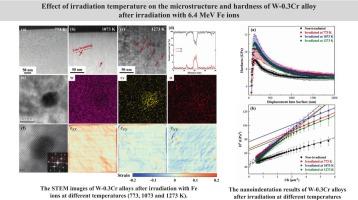辐照温度对6.4 MeV Fe辐照后W-0.3Cr合金显微组织和硬度的影响
IF 7.9
2区 材料科学
Q1 MATERIALS SCIENCE, MULTIDISCIPLINARY
引用次数: 0
摘要
W-0.3 at。用6.4 MeV Fe离子在773、1073和1273 K下辐照% Cr合金样品,损伤峰为0.26 dpa。利用掠射x射线衍射(GIXRD)、透射电子显微镜(TEM)和纳米压痕测试研究了其显微组织、缺陷和硬度的演变。GIXRD结果表明,衍射峰向较低的2θ值移动,表明在高温辐照后,晶格膨胀是由辐照缺陷引起的。透射电镜观察发现,随着辐照温度的升高,位错环的尺寸基本保持不变,而其数量密度则呈下降趋势。773 K辐照后,W-0.3Cr合金中Cr未析出。相比之下,在1073和1273 K温度下辐照的样品中,析出相的尺寸和数量密度都有所增加。在所有样品中观察到辐照硬化,主要归因于位错环的存在。考虑位错环和Cr析出相的影响,采用弥散势垒硬化模型对硬度变化进行了估计。该模型评估的数值明显大于纳米压痕试验获得的值。这种差异是由于沉淀使W基体中的溶质Cr原子耗竭所致。本文章由计算机程序翻译,如有差异,请以英文原文为准。

Effect of irradiation temperature on the microstructure and hardness of W-0.3Cr alloy after irradiation with 6.4 MeV Fe ions
The W-0.3 at.% Cr alloy samples were irradiated with 6.4 MeV Fe ions at 773, 1073 and 1273 K, and the damage peak was 0.26 dpa. The evolution of the microstructure, defects, and hardness was investigated using grazing-incidence X-ray diffraction (GIXRD), transmission electron microscopy (TEM) and nanoindentation tests. The GIXRD results showed that diffraction peaks shifted towards lower 2θ values, indicating that lattice swelling was caused by irradiation-induced defects after irradiation at elevated temperatures. According to the TEM observations, the size of the dislocation loops remained nearly constant, while their number density decreased with an increase in irradiation temperature. The precipitation of Cr was not observed in the W-0.3Cr alloy after irradiation at 773 K. In contrast, it was significant in the samples irradiated at temperatures of 1073 and 1273 K, showing increases in both the size and number density of the precipitates. Irradiation hardening was observed in all samples, primarily attributed to the presence of dislocation loops. The hardness change was estimated with the dispersion barrier hardening model by taking into account the contributions of dislocation loops and Cr precipitates. The values evaluated with the model were significantly larger than those obtained with the nanoindentation tests. This difference was ascribed to the depletion of solute Cr atoms from the W matrix by precipitation.
求助全文
通过发布文献求助,成功后即可免费获取论文全文。
去求助
来源期刊

Materials & Design
Engineering-Mechanical Engineering
CiteScore
14.30
自引率
7.10%
发文量
1028
审稿时长
85 days
期刊介绍:
Materials and Design is a multi-disciplinary journal that publishes original research reports, review articles, and express communications. The journal focuses on studying the structure and properties of inorganic and organic materials, advancements in synthesis, processing, characterization, and testing, the design of materials and engineering systems, and their applications in technology. It aims to bring together various aspects of materials science, engineering, physics, and chemistry.
The journal explores themes ranging from materials to design and aims to reveal the connections between natural and artificial materials, as well as experiment and modeling. Manuscripts submitted to Materials and Design should contain elements of discovery and surprise, as they often contribute new insights into the architecture and function of matter.
 求助内容:
求助内容: 应助结果提醒方式:
应助结果提醒方式:


